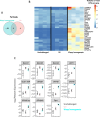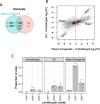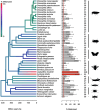Recognition of nonself is necessary to activate Drosophila's immune response against an insect parasite
- PMID: 38644510
- PMCID: PMC11034056
- DOI: 10.1186/s12915-024-01886-1
Recognition of nonself is necessary to activate Drosophila's immune response against an insect parasite
Abstract
Background: Innate immune responses can be activated by pathogen-associated molecular patterns (PAMPs), danger signals released by damaged tissues, or the absence of self-molecules that inhibit immunity. As PAMPs are typically conserved across broad groups of pathogens but absent from the host, it is unclear whether they allow hosts to recognize parasites that are phylogenetically similar to themselves, such as parasitoid wasps infecting insects.
Results: Parasitoids must penetrate the cuticle of Drosophila larvae to inject their eggs. In line with previous results, we found that the danger signal of wounding triggers the differentiation of specialized immune cells called lamellocytes. However, using oil droplets to mimic infection by a parasitoid wasp egg, we found that this does not activate the melanization response. This aspect of the immune response also requires exposure to parasite molecules. The unidentified factor enhances the transcriptional response in hemocytes and induces a specific response in the fat body.
Conclusions: We conclude that a combination of danger signals and the recognition of nonself molecules is required to activate Drosophila's immune response against parasitic insects.
Keywords: Drosophila melanogaster; Immune recognition; Parasitoid wasps.
© 2024. The Author(s).
Conflict of interest statement
The authors declare that they have no competing interests.
Figures





References
Publication types
MeSH terms
Grants and funding
LinkOut - more resources
Full Text Sources
Molecular Biology Databases
Research Materials

